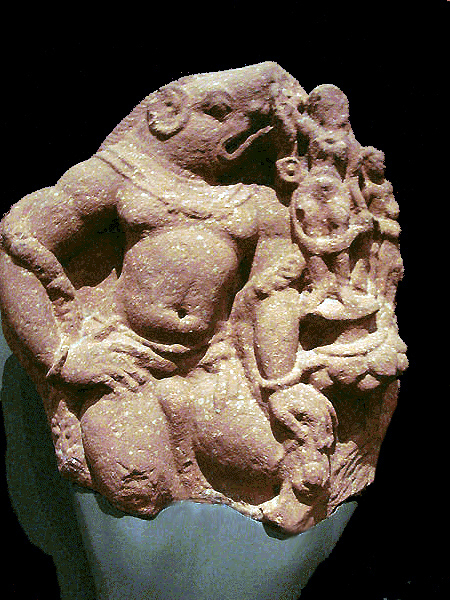Archaeology and Vaishnava Tradition, Part Twelve
BY: SUN STAFF - 21.1 2019

Vasudeva (Vishnu), Mathura, c. 400 A.D.
Part Twelve of a monograph by Ramaprasad Chanda, published by the Archaeological Survey of India, 1998.
[Continuing discussion of the fragmentary stone inscription from Mahakshatrapa Sodasa referring to Bhagavat Vasudeva at Mathura…]
Prati must be restored at the end of line 8 to form prathishthapito with shthapito in the beginning of line 9. In line 8 the word preceding toranam and ending in lam and the word following toranam and beginning with ve may be restored as chatuhsalam and vedikarespectively. Two words are now wanting to complete the fragment:
(1) a word of two aksharas in line 7 between Mahasthana and the restored chatuhsa;
(2) a word of three or four aksharas after Sodasa[sya] in line 11.
Though we cannot restore those words with certainty, we can guess their meanings. The word in line 7 after mahasthana probably denoted 'shrine' and the missing word in line 11, as the verb samvart[e]yatam in the following line shows, must have been in dual number and denoting dominion. The fragment, thus restored, reads as follows:
6. vasuna Bhagava[to Vasude]
7. vasya mahasthana…[chatuhsa]
8. lam toranarh ve[dikh prati]
9. shthapito prito bh[avatu Vasu]
10. devah svamisya [Mahakshatra]
11. pasya Sodasa[sya]…
12. samvart[e]yatam.
Translation
"By …vasu a quadrangle enclosed by four buildings (chatuhsalam), a pillared gateway (toranam) and a square terrace in the middle of the courtyard (vedikah) have been built (at the shrine at) the great place of the Bhagavat Vasudeva. May Vasudeva be pleased. May (the dominion) of the lord, the mahakshatrapa Sodasa, endure."
Bhagavato Vasudevasya Mahasthana may also be interpreted as "the great shrine of the blessed lord Vishnu" on the analogy of another Brahmi inscription of Mathura which records: [1]
bhagavato nagendrasya Dadhikaranasya stane silapatto pratishthapito
"A stone slab has been dedicated in the temple of the blessed lord of serpents Dadhikarnna."
The rendering of stana (Skt. sthana) as 'temple' (devakula) is justified by another Brahmi inscription of Mathura which reads:
Danam Devilasya Dadhikarnnadevikulikasya [2]
"The gift of Devila, the servant or priest at the temple of Dadhikarnna."
In modern Indo-Aryan vernaculars sthana (Astana) is used indifferently of an altar or a place of worship of a deity as well as of a spot sacred to the memory of a holy man. In the Sarnath inscription of Mahipala, king of Gauda, of Samvat 1083, mahasthana is used in the latter sense in the compound ashtama-hasthanasailagandhakutim denoting "a stone gandhakuti(temple) of the eight great places, i.e., containing a slab illustrating the scenes (of Buddha's life) that took place on the eight principal places." [3]

Lord Varaha, 3rd c., Mathura
FOOTNOTES:
[1] E. I., Vol. I, p. 390, No. 18; Luder's List, No. 85
[2] Ind. Ant., Vol. XXXIII, p. 102; Luder's List, No. 63
[3] A. S. R., 1906-07, Pt. II, p. 99






































